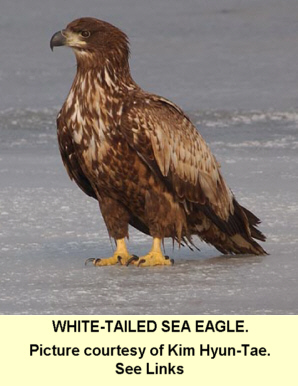
Haliaeetus albicilla.
WHITE-TAILED SEA EAGLE.
Haliaeetus albicilla.
IDENTIFICATION. White-tailed Sea Eagle is the fourth largest eagle in the world and Britain's largest bird of prey. Broad rectangular wings, similar to a vulture, and a large prominent pale beak distinguish this rare eagle. The head is large and pale in colour, the tail broad and rounded. On the adults the plumage is dark brown with the unmistakable white tail. Young birds are dark and have a tail that is more 'wedge' shaped.
Could only be mistaken for another eagle such as the Golden Eagle.
IN FLIGHT. White-tailed Sea Eagles are not great fliers, preferring to be perched on some high vantage point. When soaring the long wings are held flat.
DISTRIBUTION. A bird of the sea coasts and lakes the White-tailed Sea Eagle is a resident of Greenland, Europe and Asia with some winter migration to South Asia. Due to persecution it became extinct in Britain in 1916. In the early 1980's the eagle was reintroduced into Scotland with some success.
WHEN SEEN. All year round.
FOOD. Generally fish. Occasional birds, with waterfowl taken to the size of geese. Mammals to the size of hare. Carrion.
BREEDING. March-May. 1 to 3 eggs laid in a large (1.5m) stick nest in tall trees or on cliffs. Young hatch after 38 days, fledging 70-80 days later.
SIZE. 69-91cm (27-36ins)
WINGSPAN. 250cm (8ft 3in)
CALL. A 'Bark' or 'Yap' like call.
FALCONRY.
Not generally used in falconry.
NB. If you buy one of these raptors it should be fitted with a closed leg ring and have an Article 10 form with it (any queries check with DEFRA).
Falconry marks
